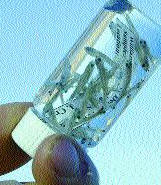|
http://www.heraldandnews.com/articles/2004/11/08/news/top_stories/atop1.txt
Suckers hang around restored
wetland
Former cow
pasture near Modoc Point now sucker habitat
HERE for KBC commentary
 |
|
Leslie Bach, a hydrologist with the
Nature Conservancy, talks about the
newly formed wetlands beside Upper
Klamath Lake near Modoc Point. The
wetlands are on former pasture land of
Goose Bay Farms. |
|
November 8,
2004
By DYLAN DARLING
MODOC POINT - Tiny
juvenile suckers foraged this summer in a
shallow bog that once served as a cow pasture
beside Upper Klamath Lake.
The appearance of the endangered fish was
particularly rewarding for the Nature
Conservancy, which bought the land and
breached a dike to let lake water flow in and
out of the parcel to create sucker habitat.
"It is showing us
that if we open up areas, they will use them,"
said John Crandall, the Klamath Basin
fisheries ecologist for the Nature
Conservancy. "Before, that was just theory."
Last fall the Nature Conservancy used
excavators to cut a pair of notches in the
decades-old dikes on the south pasture of
Goose Bay Farms.
The pasture is now
shallow marsh with heavy vegetation. Untold
numbers of endangered Lost River and shortnose
sucker larvae found their way into the marsh.
Crandall said he has caught thousands of
sucker larvae and juveniles during his
sampling this year.
By now the fish are
several months old.
But there still is a mystery: Where do the
older juveniles and young suckers go?
Scientists have been
able to find adult suckers ranging in age from
five years to more than 40 years. But younger
suckers are hard to come by.
U.S. Geological Survey and Oregon State
University researchers are among those seeking
answers.
"We haven't really
been very successful in catching those age
classes," said Mark Buettner, a fisheries
biologist with the U.S. Fish and Wildlife
Service.
He said scientists have been able to catch
younger fish in open water of Gerber Reservoir
and Clear Lake. They just aren't showing up in
Upper Klamath Lake.
 |
John Crandall holds up a
vial full of the preserved sucker larvae
that he collected in the newly formed area
of Upper Klamath Lake near Modoc Point.
Crandall is a fisheries ecologist with the
Nature Conservancy.
It's unclear
whether the scientists are sampling in the
wrong spots, or if suckers in that age
group aren't surviving, Buettner said.
While the mystery of the young suckers
remains, the Nature Conservancy plans to
carry on with creating more rearing
habitat for larval suckers. |
The Nature
Conservancy is adding another breach to
increase the flooded area of the pasture from
about 165 acres to 300 acres. When the lake is
full, water is about 4 to 5 feet deep on the
pasture.
And the pasture is just the start.
The Nature
Conservancy plans to start on a larger project
next summer. Along with the 2,700-acre Goose
Bay Farms it bought in 1999, the group also
has the 4,500-acre Tulana Farms purchased in
1996. The Williamson River flows through the
properties, and the Nature Conservancy plans
to restore sucker habitat on a grand scale.
"All of this used to be lake-fringe wetland,"
said Leslie Bach, a hydrologist for the group,
sweeping her hand across an aerial photo of
the Williamson River Delta.
Crandall said the
larvae are using the re-opened marsh because
it offers them shelter, food and warmth.
"Larval and juvenile sucker habitat is really
a key in the Klamath Basin," Crandall said.
Crandall said the
suckers he found in the marsh were spawned in
the Williamson River. Having more habitat in
the river's delta would help those fish
particularly.
Mark Stern, Klamath Basin director for the
Nature Conservancy, said it would also help to
have other places opened up for sucker rearing
habitat on the fringes of the lake.
"I think there are a
number of pretty good options to do this
around the lake," Stern said.
Crandall said the success of the re-opened
marshland bodes well for future sucker habitat
restoration projects in the Basin.
"If we open up these
areas, they will come," he said. |

